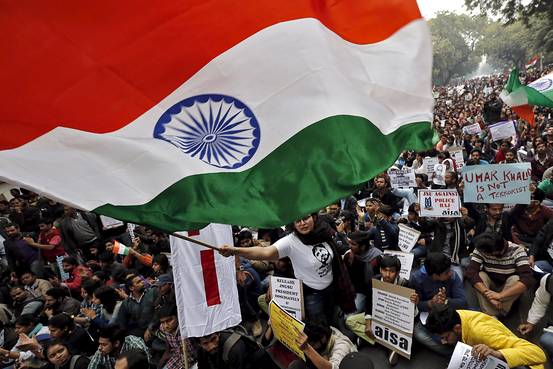
My previous essay in this series of Essays for Our Times addressed to India got three hundred shares on fb. This surprising fact has made me keep quiet for a long time, wondering what to write next. It was on “why I am an Indian.” Meanwhile, while I go on reifying the definitions of nation, India and what it means to be an Indian today or who an Indian is or should be, philosophically speaking, now, BJP has lost in five state elections. I started this series, this second book of mine, with a one point agenda, which was to make BJP lose in the 2019 elections. I can say that somehow I have partly succeeded along with all those involved in the same fight. But the fight is not by any means over. We cannot stop fighting unless the fascist forces in India are fully defeated.
At the same time, following on from my first book, I had begun to outline India’s real problems like the Dalit one, which is sociological, of air, and water, and was about to go on to food, but went on instead to understanding that there was a much deeper problem at hand which was the one referring to the thorny issue of national identity, so my last few essays have dealt with that issue.
The comments on my wall to my previous article and reading today’s press as well as being able to read everyone’s opinions on today’s social media networks has made me understand something that is worrisome. People, including Rahul Gandhi, are ready to put up with the BJP and its satellites, and enter into a dialogue with them, showing to me that India is after all not a secular country and there is precious little to choose between it and a Saudi Arabia, a precious little that is being eroded steadily by politics without an eye being kept on what the country really needs. The attitude of both Rahul and his cohort is similar to that of their opponents which is one of giving the people what they want –
Ram Mandir or loans from IMF, both not priorities – and not what is actually essential for the country’s growth. As in the time of the breaking down of the Babri Masjid done during Congress rule what this means is as far as secularism is concerned India remains a country that is sliding towards unashamedly declaring itself ruled by a Hindu upper caste upper class bastion, and the choice offered to people is one of choosing between one such set in INC and another such set in BJP. However I believe that there is a third set consisting of people like me who often do not vote or vote NOTA etc or vote looking at the candidate to at the ideology of the party and so on and so forth.
This set, as I stated earlier, is not Hindu or Muslim and it is not Congress or BJP. I will talk on this now.
Jacques Lacan was the psychologist who spoke of the Other. By the Other Lacan meant initially “other people,” a term he borrowed from Hegel, signified primarily by the Muslims in India to upper caste, upper class north Indian Hindus or Brahmins and Nairs in the South etc.
Muslims are to many Hindus, I have come to increasingly understand, what the Jews were to Nazi Germany, as many people from the North have a version of history, distorted or not, whereby the golden age of what they imagine was a unified Bharath, under empires like that of the Mauryas and Guptas, seemingly, was put on a decline by the Mughal invasion, and Buddhists were failures in being too soft in facing the Islamic sword, and the Hindus lost their power, meaning the Brahmins and the Kshatriyas and the Vaishnavites did, by which power was meant not only their power of/over their kingdoms but also over the shudras and mlecchas and Dalits and tribals. That this version of history is primarily North Indian is something they are not aware of or don’t want to be aware of.
This fear of Muslims as the other is compounded by groups like the RSS, Bajrang Dal, Hindu Vahini and so many more such groups now proliferating after BJP came to power who claim that Muslims increase in number drastically in population and thus will soon become more than twenty five percent of the Indian population and will then demand another country in India, which is the fear that causes them to unleash ‘pogroms’ on Muslims like the one in Gujarat in 20002, the fear of the other.
Thus a group of Hindus in India are driven by three things towards self definition of their identity which is a nostalgia for a golden past for the loss of which they lay the blame on the doorstep of the Muslim invasion by the Mughals, for which they hate them, along with a fear of the presence of an increasing population and migrants, rightly or wrongly, and a desire for a restoration of an imaginary past of glory where the nation-state is purged of the other that Muslims are first. Compounding this is the memory of the Partition of greater Bharath into India and the ever smouldering wound that is Kashmir, that again pits both sides against each other constantly in a never ending, ceaseless, escalating war, made even more complex now with questions like Bangladeshi refugees who are both Hindus and Muslims, but are seen as only Muslims, and Rohingya Muslims.
In other words, Hindu identity has got caught up with the unfortunate strands of hatred, fear and the fascist desire for a purity by cleansing itself of the other which is no longer possible in today’s world even as it never was possible as no such thing called purity ever existed in ideological terms, as Sartre understood, as existence always precedes essence and not vice versa.
However, India has, not only, religiously speaking, as it is religion that Indians understand most, one other in it as understood by these upper caste upper class Hindus who hold to this carefully built construct of what Muslims are, but many “others” like
a. tribals,
b. Dalits,
c. Sikhs,
d. Buddhists,
e. Jains,
f. Christians,
g. Mormons,
h. Church of Scientologists,
i. Seventh Day Adventists,
j. Jehovah’s Witnesses,
k. atheists,
l. antitheists,
m. Satanists,
n. agnostics etc.
This is problematic as as both groups probably view these others as ‘the other of the other,’ the underbelly of the other, that can be dispensed with in the overall picture as democracy or rule or might or power or governance is a matter of numbers. but the recent elections just conculded have shown that they cannot be dispensed with, that minorities and people’s groups matter much more than thought of before, whether in terms of party affiliations or in terms of class or gender or holdings, or occupation etc.
Again, India not only has the above groups in matters of religion and more, as I have wanted to highlight the pattern rather than the whole matter, but also another set of political groups that were already there and are now rising according to today’s needs.
There are the regional parties like:
1. MNF
2. TRS
3. BSP
4. AAP (Delhi)
5. The neo- Marxists (rising up in places like Rajasthan)
6. The Independents (whose support becomes critical in the case of hung assemblies or Parliaments.)
7. Samajwadi Party.
8. DMK
9. JD (S)
10 RJD
11. TDP
12. Anarchists, violent and non violent
Etc. Etc. Etc.
There are also groups of people India does not think matters but do greatly.
Women. (feminists, especially)
Children
The differently abled
Farmers
Nomads or semi-Gypsies (the Kathua case highlights their plight)
Migrant labourers within the nation
Subcultures that are new in origin like the New Age religious groups coming even from places like Japan or even economic grups like Amway etc.
Those whose livelihood and habitats (ecological &environmental) are affected by industrial and technological change like farmers, tribals, reappearing again here in this list too, the people who deal in making and selling handicrafts, our craftsmen etc.
These tortuous lists I am making or drawing up are not aimless. They are meant to show through a new kind of demography delineation and cartography that a nation while a construct and a half real or half imagined community that is both something that extends into the past and across space and place and so not only geographical but in memories and made of people, land, flora and fauna is also sometihng creating itself now, but haphazardly and not in any planned manner, and while this leads me to use Gayathri Chakraborty Spivak’s “strategic essentialism” as a tool to map it, my real aim is to show that its real problems are not being addressed by the BJP or the Congress, whether it be disaster management or food security or ecological and einvironmental security etc. What can we do against or ongioing financial collapse and international debt, for instance? Demonetisation and GST failed in this respect, as it was done by poor planners who do not know the ABCD of economics, The RBI is also under threat now.
To return to the main thread of this essay, Lacan posits an Autre/Other that is the big Other which for the BJP and to the Congress is symbolized by upper class, upper caste Hinduism and not democracy. Democracy is also wrong as it speaks of the rule of the majority when what we need now, as clearly demonstrated by the recent elections, is a rule of minority coalitions working together for the common best interests of the nation. To redress these wrongs we have to see that the big Other is not a religion’s or worldview’s (Hindusim’s/ Islam’s/ Science and Technology’s/ Capitalism’s ) best version as a grand narrative – the one ring to rule all the other rings – as we live in the time of post modernity as pointed out by Lyotard where such grand narratives no longer work even as they never worked, or a political party’s best version, or an idealized view of a nation as the greatest when it is not, but a projection of a vision of the nation as a possible future Utopia and Arcadia, a heaven on earth, accompanied by a withering away of the state as administative and governmental apparatus as the citizens in it are all happy and self governing and peaceful and community conscious , to which one has to strive forwards, which is the only way to create a sustainable growth pattern for the country that will lead to our actual halting of and revamping the present steady decline of its future prospects and those of our people.
Dr A.V. Koshy is an established author and writer who is a poet, critic and artist. He has a doctorate in Samuel Beckett’s Poems in English from the University of Kerala, now published. He has co-authored and published a monograph of essays called Wrighteings: In Media Res and has several, published research papers to his credit. His greatest desire is to build a village for people having autism where all their needs are met. He runs an NGO called “Autism for Help Village Project” with his wife for this dream to come true. He has fourteen other books out now as fiction writer, literary critic, poet, academician, literary theoretician, essayist, editor, anthologist, co -editor, co-author and co-contributor. His latest and perhaps best book is a collection of short stories Scream and Other Urbane Legends.
© Dr Koshy AV













































